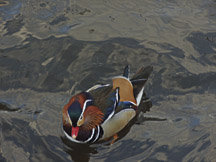Last week, a North Bergen resident visiting James J. Braddock Park was stunned when he came across a duck with elaborate and colorful feathers.
“The first thing I thought about was a parrot, because its colors are so brilliant,” said Arthur Presslaff.
Presslaff, who calls himself a “bird whisperer,” said that around the age of 13, he discovered he had a special intuition about animals. He now frequents the park almost on a daily basis.
He was taken aback when he saw the exotic bird mingling with the indigenous mallard ducks at the park last week.
Fearing that the bird was meant to be in a tropical climate, Presslaff took photos and went online to research its origins. He said he learned that it was a very rare Asian bird called a Mandarin and that from its size, it was very young. According to its feathers, it is male.
“I’ve never seen anything like this Mandarin.” – Arthur Presslaff
________
According to the Philadelphia Zoo, which houses a bird like that it in its bird valley, Mandarin ducks, or Aix galericulata, are native to eastern Asia and Japan, but now also have populations in western Europe and Great Britain, where humans introduced them.
“Male Mandarin ducks are considered by many to be the most beautifully colored of all waterfowl,” says the zoo’s website, which explained that they have bright orange “sails” and distinctive plumage.
The website also says that in captivity, Mandarin ducks live six or seven years, but many can live to over 10.
Presslaff said that through his research, he learned that the birds were once widespread, but due to forest destruction, they have been reduced to below 1,000 pairs in Russia and China. Japan is believed to still hold 5,000 pairs.
He also found that the species’ hens often reunite with the males that they originally mated with, which may be the origin of the Chinese proverb “two Mandarin ducks playing in water” which describes happy couples.
How did it get into the park?
When Presslaff originally saw the bird last week, it reminded him of the colony of green parrots in Edgewater, N.J. that have erected huge nests in the trees among river road. Quaker Parrots, or Monk Parakeets, have inhabited the area since the 1970s, when it is rumored that they were mistakenly released at JFK Airport. Since that time, the tropical birds have thrived and multiplied.
According to New Jersey Audubon naturalist and teacher Michael Pollock, it is likely that the Mandarin was released into the park by a private owner. Pollock explained that while such birds are often kept in zoos, they are also widely available in the United States by breeders and are kept as caged pets.
“Often someone has raised it and couldn’t keep it anymore,” said Pollock. “[They] take it down to the ducks at the local park, where people feed them.”
He said that situations like this occur in New Jersey every couple of years.
“It will probably survive for awhile,” said Pollock. “It will do alright there as well as any other duck, [but] it is not the healthiest of situations for them.”
“If that is true, there is something wrong with the laws,” said Presslaff. “It should be a protected species.”
According to published reports, activists in Edgewater have been fighting for their parrots to be a protected species, while the Mandarin population in England is also not protected because the species is not indigenous.
Fate of Mandarin
Presslaff said that he has not seen the bird for two days, but that there are many places in the park for it to hide. He also said that it appeared very healthy and accepted food from him, which according to Pollock may be a sign that it was a privately kept bird.
It’s also not the first time he has seen an unusual bird at the park. Last year he believes he witnessed a whooping crane.
Hudson County Spokesperson James Kennelly said that anyone who witnesses an unusual non-indigenous species should call the Division of Parks at (201) 795-6000.
While there is no official protocol, their staff will decide whether the species will be a threat to the local animal population and will handle it on a case-by-case basis. If the animal has to be removed, the local animal service agency will be called to assist the county.
“Animals just don’t survive well in the park,” said Kennelly. “Winters in the park are very difficult. [Releasing them] is a cruel thing to do by individuals that have purchased these kinds of creatures.”
Tricia Tirella may be reached at TriciaT@hudsonreporter.com.
